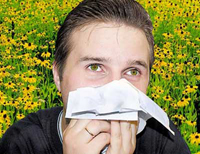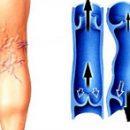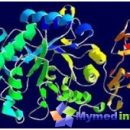The lion's share of dermatitis, rhinitis, conjunctivitis and pulmonary diseases constitute cases of allergies on dust mites. Where these villains nest and is it possible to get rid of dust ticks?
Content
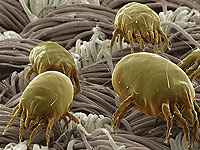
Dust surrounds us everywhere. It is worth wing the furniture and after an hour of the dust dust a smooth layer again lie on the floor, on sofas and on carpets, dust in our bed and in the air of the premises. It not only testifies to the mess, but also represents the danger of health due to the ticks contained in it, capable of causing sensitization and the development of allergies. For example, in 80% of cases, children's bronchial asthma doctors bind to precisely with allergies on dust ticks.
Know the enemy in the face
Dust pliers — These are microscopic spider insects, ranging from 0.1 to 0.5 mm, inhabit the colonies of 100-10000 individuals. The lifespan of the tick is an average of 80 days, the number of eggs, laid by the female, approximately 60 pieces.
Scientists have found that 1 g of home dust contains 100 ticks, which are representatives of 150-200 species, while the main part is represented by dermatophagoid and pyroglyphide ticks that feed with dead scales of human epidermis.
Up to 500 million dead cells of the epidermis are extended daily from human skin. Per year it is about 2 kg of dry mass, so the nutritional base in the ticks is very rich.
What is the danger of dust ticks?
They do not bite, do not suck blood, but at the same time they are able to cause severe diseases of allergic nature in humans, such as:
- Bronchial asthma and respiratory allergose;
- atopic dermatitis;
- Atopic rhinitis and conjunctivitis;
- Sweep Qinkie and other diseases.
In 1972, Mulvey put forward a hypothesis about the connection of sudden child death syndrome with allergies on dust mites. According to some data, it is associated with the occurrence of such a dangerous disease as Kawasaki syndrome.
Confirm or refute the diagnosis «Dust allergy» can only doctor, but the presence of cough, difficulty breathing, nasal congestion, tears should make thinking about the problem.
The threat to a person is even not insects themselves, and their excrement containing substances capable of destroying the cells of human skin and increase its sensitivity to allergens of various kinds. The chitine covers of the dead individuals, getting into the respiratory tract, annoy them, alleviating the penetration into the mucous membranes of pathogenic microorganisms.
In bed with the enemy
Dusty tick refers to synanthropic organisms, he can live only with people, he loves warm, moderate humidity and hates sun rays. Ticks can be found primarily on upholstered furniture, carpets, bookshelves, they love to get a job in home slippers of the owners, in the plaids and cape. But the favorite place of their habitat is the bed. It is straightforwards a resort area where the temperature does not fall below 22 0C, humidity supported at no lower than 55% and most importantly, always in abundance.
On a double bed with the owners can «relax» 300-400 million dust mites. Pillows, mattresses, blankets, bed linen, pajamas, all this literally tears with small, infinitely tasty, proceeding and breeding insects. Dryness, irritation and itching — there are the first manifestations of adverse cohabitation.
How to get rid of dust ticks?
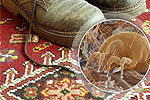 It is impossible to get rid of them, and no need. After all, in nature everything is arranged so that «A holy place is never empty», So, niche of the ticks will immediately take someone else and not the fact that he will «Dobre» to people. In addition, scientists believe that if less than 100 ticks are contained in home dust, you can be calm, there is no harm to health. If the number of insects reaches 500 pieces per gram of dust, then there is a danger of exacerbation of allergic diseases. For a real, dangerous for a person is considered to be a dose of 1000 and even 2,000 individuals per gram. With such an amount of insects, the likelihood of allergy is high in predisposed to people.
It is impossible to get rid of them, and no need. After all, in nature everything is arranged so that «A holy place is never empty», So, niche of the ticks will immediately take someone else and not the fact that he will «Dobre» to people. In addition, scientists believe that if less than 100 ticks are contained in home dust, you can be calm, there is no harm to health. If the number of insects reaches 500 pieces per gram of dust, then there is a danger of exacerbation of allergic diseases. For a real, dangerous for a person is considered to be a dose of 1000 and even 2,000 individuals per gram. With such an amount of insects, the likelihood of allergy is high in predisposed to people.
What is the conclusion? The fight against ticks should be aimed at keeping their number under control.
- It is necessary to get rid of upholstered furniture with a pile upholstery, if possible, replace with leather or leatherette.
- Replace curtains on blinds and wipe them weekly from dust.
- Interior items that are not to be washed, you need to process acaricidal agents.
- You should remove carpets, get rid of soft toys.
- It is better to replace dying and feather bedding on products with synthetic fillers using waterproof covers for mattresses and pillows, not forgetting to clean them once a month.
- Wash bedding is recommended in high temperature mode and after drying to iron hot iron with steam.
- Reduce the amount of ticks will help the daily wet cleaning of premises with salt solution (10 tablespoons of salt on the water bucket) or special hypoallergenic acaricidal detergents.
- Books should be stored on closed shelves and regularly clean with a vacuum cleaner.
- For cleaning rooms, use only a vacuum cleaner with a HEPA filter (not lower than 12th grade) or aqua filter. Old vacuum cleaner with a sack-dust collector — This is an allergenic bomb in the house and infection.
- Control the humidity of air indoors using dryers.
- Air conditioning and special ion cleaner.
New clean bed, perfectly clean, well-kept house, lack of dust deposits — about ticks and allergies can be forgotten forever.





